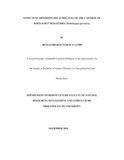Please use this identifier to cite or link to this item:
https://cris.library.msu.ac.zw//handle/11408/3686| Title: | Effects of different bio-fumigants on the control of root-knot nematodes (Meloidoygne javanica). | Authors: | Paskwavaviri, Netsai Sharon | Keywords: | Root-knot nematodes. | Issue Date: | 2018 | Publisher: | Midlands State University | Abstract: | Root-knot nematodes are one of the major economically important pests causing yield losses of up to 80% in many regions of the world including Zimbabwe. Control of nematodes has been mainly based on use of synthetic nematicides and these have negative impacts on the environment, as a result there is growing interest in alternative methods of management that are economically viable and non-polluting such as Bio-fumigation. An In vitro experiment was carried out in the 2018/19 growing season at Horticulture research Centre to investigate the use of different bio-fumigants (Brassica juncea, Brassica carinata, purple stem Cleome gynandra and green stem Cleome gynandra) at varying rates of 3, 5 and 10grams on the control of root-knot nematodes. The experiment was laid out as a 4×3 plus 1 factorial arranged in a Compete Randomised Design (CRD) with 13 treatments replicated 4 times. Nemacure®400Ec at 0.5ml/10mls water was used as a positive control. 100 juveniles of Meloidogyne javanica pure culture was obtained from Tobacco Research Board and were exposed to the different treatments and data was collected on the number of dead juveniles and number of eggs. Results show that there was significant interaction (p≤0.01) on the effects of bio-fumigants and rates on nematode mortality Brassica juncea at 10grams recording the highest juvenile mortality when compared to other bio-fumigants. There was no interaction (p≤0.09) between bio-fumigant type and rates on number of nematodes eggs. However, there was significant (p≤0.01) difference on the effect of the individual factors on number of nematode eggs recorded. Brassica juncea recorded the least number of nematode eggs followed by Brassica carinata, purple Cleome gynandra and green Cleome gynandra respectively. There was significant (p≤0.03) difference on the efficacy of different bio-fumigants rates on number of nematode eggs with 10grams recording the least number of eggs. Volatile compounds (ITCs) Isothiocynates produced from the hydrolysis of glucosinolates in plant tissue could have contributed to juvenile mortality and reduction in number of eggs recorded. It can therefore be concluded that use of Brassica juncea at 10grams as a bio-fumigant could be an alternative way of controlling root-knot nematodes. | URI: | http://hdl.handle.net/11408/3686 |
| Appears in Collections: | Bsc Crop Production And Horticulture Honours Degree |
Files in This Item:
| File | Description | Size | Format | |
|---|---|---|---|---|
| Paskwavaviri Netsai Sharon.pdf | Full Text | 745.29 kB | Adobe PDF |  View/Open |
Page view(s)
96
checked on Jan 14, 2025
Download(s)
50
checked on Jan 14, 2025
Google ScholarTM
Check
Items in MSUIR are protected by copyright, with all rights reserved, unless otherwise indicated.


